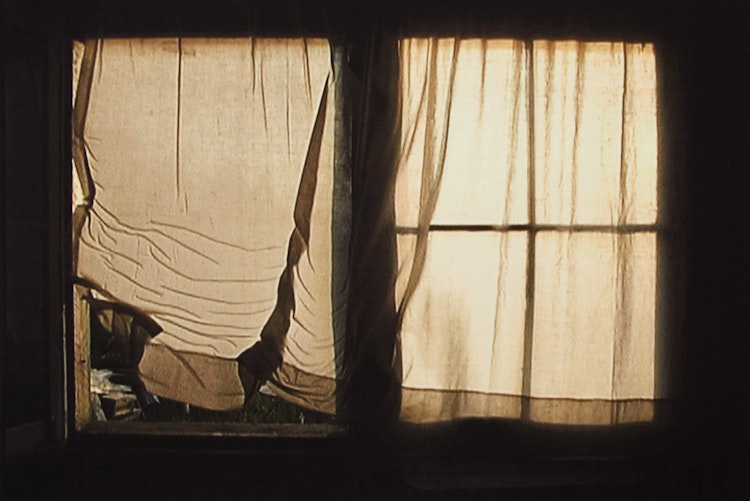Solar Breath (Northern Caryatids), still from video installation by Michael James Aleck Snow

Michael Snow
Solar Breath (Northern Caryatids), still from video installation
archival inkjet print
Gallery TPW Silver Editions 2011
signed, titled (typed), dated 2011 and numbered 3/23 on an accompanying Certificate of Authenticity; unframed
17 x 22 ins ( 43.2 x 55.9 cms ) ( sheet )
Auction Estimate: $600.00 - $800.00
Price Realized $600.00
Sale date: July 25th 2023
Private Collection, Toronto
For several summers I have attempted to capture this wind phenomena on tape or film, with inconsistent results. Some summers it never happened at all. What I saw in these sun-and-wind events was their potential as art. I did not record these “events” to share this modest phenomenon from my daily life with others. No, the rich play of light, surfaces and durations said to me: this real, unstaged event contains the elements which are essential for a contemplative time-light-motion work of art, a “motion picture” with “plastic” values and reverberant associations which will reward many viewings.
In the videotape, “Solar Breath”….which I have made of this window – I designed and built the curtain -the “gestures” which produce the images often include the curtain blowing high enough into the room for one to have (each time framed differently) a view of the outside. One glimpses evergreen trees, and stacks and piles of cut firewood. A very northern Canadian wilderness scene.
One also glimpses a blue, gridded, metal-framed rectangle, very sci-fi, very “unnatural.” It is a solar panel, which is charging from a battery that is powering the camera. The cable from the panel is visible as it comes through the window/screen. The most amazing thing is that often the cloth flaps out, then is sucked back against the almost invisible plane of the screen (smack!) and then holds still, each time a different composition of folds, for as long as four seconds.
While on one level, “Solar Breath” is merely a fixed-camera documentary recording, 62 minutes long, it is also the result of years of attention.
Michael Snow, September 2002. Excerpted from the publication “Michael Snow: Souffle solaire/Solar Breath”, Galerie de l’UQAM, 2005.
Share this item with your friends
Michael James Aleck Snow
(1928 - 2023) RCA
One of Canada’s most celebrated artists, Michael Snow’s career spans decades, artistic movements, and mediums; and his renown is global. However, his creative pursuits did not begin in visual art, but rather in jazz. Born in 1928 in Toronto, Snow fell in love with jazz as a teenager and taught himself to play the piano. When deciding what to study, Snow felt a pull between art and jazz, but eventually decided to study design at the Ontario College of Art (now, OCAD University). His artistic talent was immediately recognized by his teacher, John Martin, who encouraged him to submit his work to the Canadian Society of Artists exhibition. Snow became the first student artist in the Society’s history to be exhibited. Despite his early success as an artist, Snow never abandoned his pursuit of jazz. In 1953, the twenty-five year old took a trip to Europe and worked as a musician in France, Italy, and the former Yugoslavia. Upon returning, Snow developed an interest in film and animation, in part, due to his experience as a musician.
Discussing his first film “A to Z”, Snow says:
“I was inspired at that time by studying the music and visual art that moved me the most and then imitating and modifying it. In art, the examples of Klee, Picasso, Matisse, Duchamp, and others were models to consider. But my fascination with film came about through my introduction to it as a particular process — learning what it was/is from the inside, as it were, adding frame to frame, twenty four frames passing in one second on the screen.”
By the late 1950s, Snow was painting in the abstract expressionist style. Snow sees this period as a response to the New York art scene, where he would ‘try this try that’, taking his inspiration from Newman, Reinhardt and Rothko. Art critic Elisabeth Kilbourn said of his abstract expressionist works:
“Like experimental jazz, Michael Snow’s work is ‘cool’. The classical underpinnings are never denied; the formal structure is firm and sure but (it is) stripped down to the absolute essentials.”
In 1961, Snow began using a cut-out silhouette of a woman walking in various works. In his first piece using the black cut out, “Four to Five”, he placed what would become famously known as “The Walking Woman” around Toronto in various locations and then filmed it. “The Walking Woman” became a motif that reemerges throughout his career, in all forms, including on canvas, in photographs, and even on vinyl records.
Despite rejecting the notion of himself as a Pop artist, Snow was clearly influenced by Pop Art during his time in New York from 1962-1970. He experimented with bright colours, comic book graphics, and repeating images. In 1970, he represented Canada at the Venice Biennale and the Art Gallery of Ontario exhibited a retrospective of his work, although his career was far from over. Over the next 40 years, Snow would continue to develop his practice, finding recognition around the world that very few Canadian artists have ever achieved.
Literature Source - James King and Michael Snow, Michael Snow - Lives and Works, Toronto, Dundurn, 2019
We extend our thanks to Scarlett Larry, York University graduate student in art history, for writing and contributing this artist biography.

